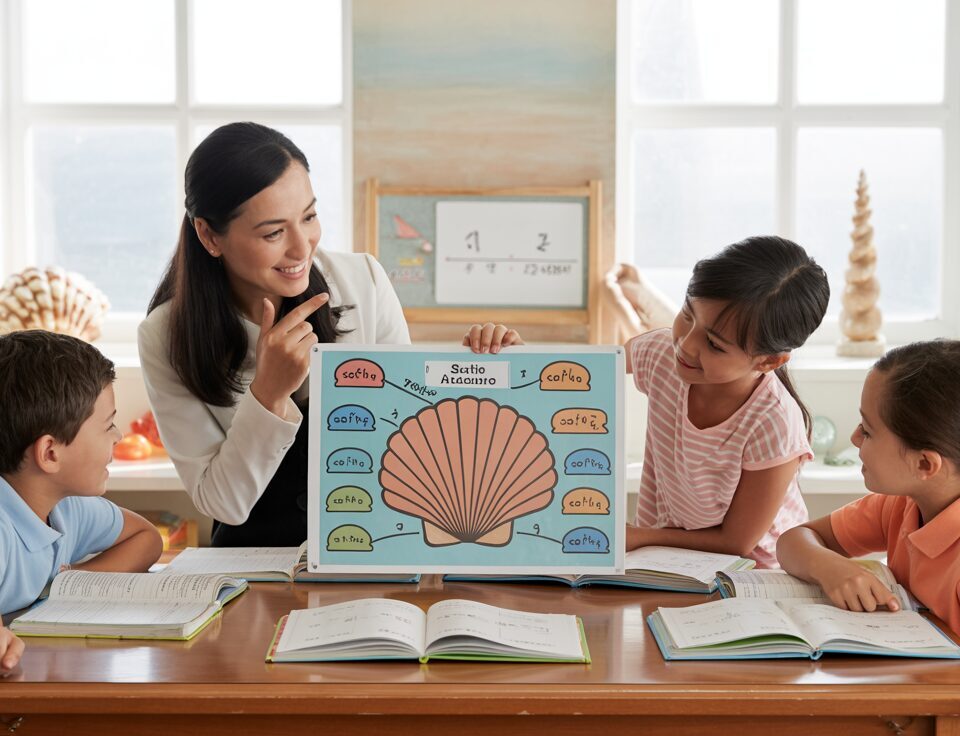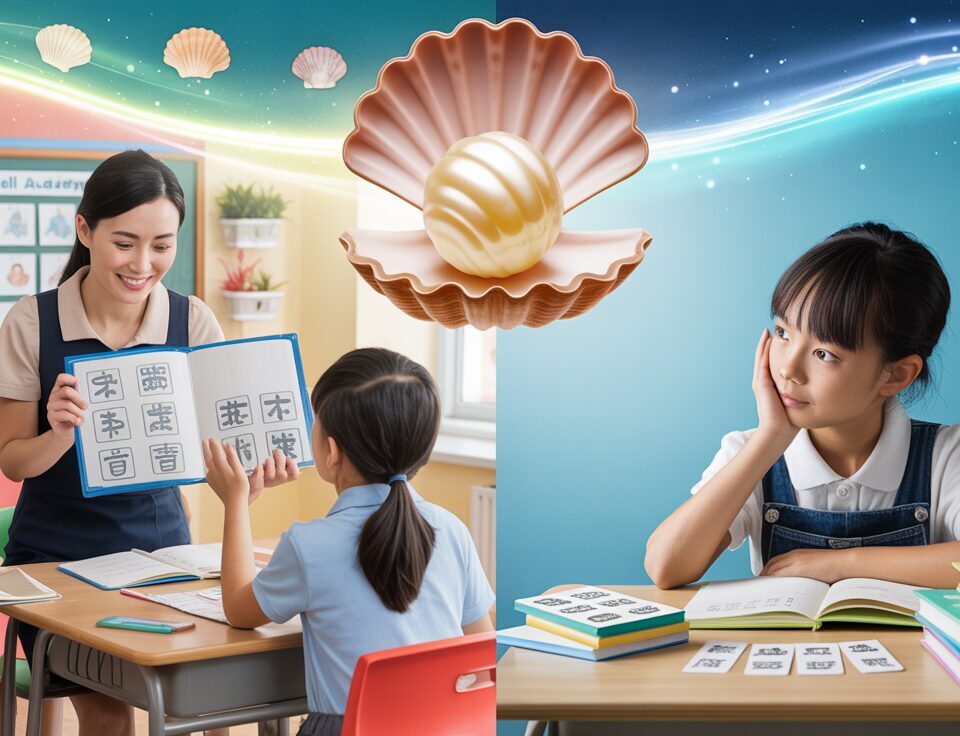
10 Fun Listening Comprehension Games for Primary 1-3 Students That Boost Language Skills
October 8, 2025
200 High-Frequency Chinese Words Every PSLE Student Should Master for Exam Success
October 8, 2025Table Of Contents
- Understanding PSLE Chinese Composition Requirements
- Essential Composition Templates for P4 Students
- Advancing Composition Skills for P5 Students
- Mastering PSLE Composition for P6 Students
- Decoding Composition Marking Rubrics
- The Seashell Method for Chinese Composition
- Common Composition Mistakes and How to Avoid Them
- Building a Strong Chinese Vocabulary Foundation
- Conclusion
For many Primary 4 to 6 students in Singapore, Chinese composition often presents a formidable challenge. The ability to weave characters into compelling narratives requires not just language proficiency, but also creativity, structured thinking, and an understanding of marking expectations. At Seashell Academy by Suntown Education Centre, we’ve witnessed countless students transform their Chinese composition writing from a source of anxiety to an opportunity for self-expression and academic excellence.
Chinese composition at the PSLE level isn’t simply about memorizing model essays or following rigid structures—it’s about developing sustainable writing skills that empower students to respond confidently to any composition topic. This comprehensive guide explores effective composition templates tailored for each primary level (P4-P6) and demystifies the marking rubrics that determine scores. Whether your child struggles with basic sentence construction or is ready to refine their narrative techniques, our proven strategies will help them navigate the journey toward composition mastery.
Let’s uncover how the right templates, combined with a clear understanding of assessment criteria, can help your child excel in Chinese composition while building a genuine appreciation for Chinese language and culture.
Understanding PSLE Chinese Composition Requirements
Before diving into specific templates and techniques, it’s essential to understand what examiners are looking for in PSLE Chinese compositions. The Paper 1 Chinese composition section typically provides students with either picture-based prompts or topic-based prompts, requiring a response of approximately 100-120 characters for P4, 150-180 characters for P5, and 180-240 characters for P6 students.
The PSLE Chinese composition assessment focuses on four key areas:
- Content and Relevance (内容与相关性) – How well the composition addresses the given topic or picture prompt
- Language Usage (语言运用) – The accuracy of grammar, sentence structure, and character writing
- Organization and Coherence (组织与连贯性) – Logical flow and structure of ideas
- Creativity and Expression (创意与表达) – Original ideas, vivid descriptions, and appropriate emotional expression
Understanding these requirements provides the foundation for developing effective composition strategies at each primary level. At Seashell Academy, we begin by strengthening these fundamental areas before introducing level-appropriate templates.
Essential Composition Templates for P4 Students
Primary 4 marks a critical transition point where students begin developing more complex Chinese composition skills. At this level, we recommend mastering three essential templates that build confidence and fundamental writing structures.
Chronological Narrative Template (时间顺序叙事模板)
This template helps students organize events in a logical sequence, particularly useful for picture compositions showing a series of actions:
Introduction (引言): Introduce the main characters, setting, and time
Development (发展): Describe events in chronological order using time connectors (首先, 接着, 然后, 后来)
Conclusion (结论): Share the outcome and a simple reflection or lesson learned
This straightforward structure helps P4 students maintain focus and avoid the common problem of disorganized storytelling. Our students at Seashell Academy’s P4 Chinese Programme begin with this template as it provides a clear framework for building narrative skills.
Problem-Solution Template (问题解决模板)
This template works exceptionally well for compositions involving challenges or conflicts:
Introduction (引言): Present the main character and the normal situation
Problem (问题): Describe the problem or challenge that arises
Solution Process (解决过程): Explain how the character(s) attempt to solve the problem
Resolution (解决): Describe how the problem was ultimately resolved
Reflection (反思): Share what was learned from the experience
This template teaches students to develop complete story arcs with clear resolution, a skill that distinguishes higher-scoring compositions.
Descriptive Experience Template (描述经历模板)
Perfect for topics about personal experiences or events:
Introduction (引言): Introduce the experience or event with when, where, who, what
Sensory Details (感官描述): Describe what you saw, heard, felt, etc.
Emotional Response (情感反应): Share how you felt during the experience
Conclusion (结论): Reflect on the significance of the experience
This template helps students incorporate sensory details and emotions into their writing, creating more vivid and engaging compositions that resonate with readers.
Advancing Composition Skills for P5 Students
By Primary 5, students are ready to incorporate more sophisticated narrative techniques and complex structures into their compositions. The following templates build upon P4 foundations while introducing new elements that prepare students for PSLE-level writing.
Three-Act Narrative Template (三段式叙事模板)
This template elevates storytelling by creating a more engaging narrative structure:
Act 1 – Setup (设置): Establish characters, setting, and introduce a potential conflict or question
Act 2 – Confrontation (冲突): Develop the conflict, present obstacles, and show character reactions
Act 3 – Resolution (解决): Resolve the conflict and include a meaningful conclusion with character growth
This structure helps P5 students create more compelling stories with proper tension and satisfying resolutions. In our P5 Chinese Programme, we emphasize how this template mirrors the narrative structure found in literature and media, helping students connect their composition skills to real-world storytelling.
Contrasting Perspectives Template (对比视角模板)
This advanced template helps students explore multiple viewpoints:
Introduction (引言): Present the situation or topic
First Perspective (第一视角): Describe one character’s experience or viewpoint
Second Perspective (第二视角): Present another character’s contrasting experience or viewpoint
Resolution/Integration (解决/整合): Show how these perspectives interact or resolve
Reflection (反思): Offer insights gained from understanding multiple perspectives
This template develops critical thinking and empathy while demonstrating more sophisticated writing abilities. It’s particularly effective for topics involving misunderstandings, conflicts, or different interpretations of events.
Cause and Effect Template (因果关系模板)
This template helps students develop logical reasoning in their narratives:
Introduction (引言): Establish the initial situation
Cause (原因): Clearly describe the action or decision that triggers subsequent events
Effects (结果): Detail the consequences that follow, with clear connections to the cause
Secondary Effects (次级结果): Explore how the initial effects lead to further outcomes
Conclusion (结论): Reflect on the chain of events and their significance
This structure reinforces critical thinking skills while helping students create more cohesive narratives where events connect logically rather than occurring randomly.
Mastering PSLE Composition for P6 Students
By Primary 6, students must refine their composition skills to meet PSLE standards. The following templates incorporate advanced techniques that target higher-level marking criteria while maintaining authentic expression.
Thematic Exploration Template (主题探索模板)
This sophisticated template focuses on exploring deeper themes:
Introduction (引言): Introduce characters and setting while hinting at the central theme
Theme Development (主题发展): Present a situation that explores the theme (e.g., friendship, honesty, courage)
Complication (复杂化): Introduce complexity or challenges related to the theme
Resolution (解决): Show how characters navigate these challenges
Thematic Conclusion (主题结论): Reinforce the central message without being overly didactic
This template encourages P6 students to move beyond simple storytelling to explore meaningful themes that demonstrate maturity and depth of thought. In our P6 Chinese Programme, we help students identify appropriate themes that resonate with common PSLE composition topics.
Character Transformation Template (人物转变模板)
This template focuses on character development, a key element in higher-scoring compositions:
Introduction (引言): Establish the character and their initial traits or beliefs
Catalyst (催化剂): Present an event or interaction that challenges the character
Internal Conflict (内心冲突): Show the character’s struggle with changing perspectives
Transformation (转变): Depict how the character evolves or changes their viewpoint
New Understanding (新的理解): Demonstrate the character’s growth and new perspective
This structure showcases psychological depth and emotional intelligence, helping students create more nuanced and compelling characters in their narratives.
Descriptive Mastery Template (描写精通模板)
This template emphasizes vivid sensory description and emotional depth:
Introduction (引言): Set the scene with initial impressions
Layered Description (层次描写): Use the five senses to create immersive descriptions
Emotional Landscape (情感景观): Connect external descriptions to internal feelings
Symbolic Elements (象征元素): Include symbolic details that enhance meaning
Conclusion (结论): Tie descriptions back to the central narrative purpose
This template helps students create more vivid, memorable compositions that demonstrate language mastery and emotional intelligence. It’s particularly effective for picture-based compositions where detailed observation is crucial.
Decoding Composition Marking Rubrics
Understanding how compositions are evaluated is crucial for strategic improvement. The PSLE Chinese composition marking rubric typically assesses work across four main criteria, with points allocated as follows:
Content & Relevance (内容与相关性) – 30 points
What examiners look for:
- Clear understanding and interpretation of the given topic/picture
- Relevant ideas that directly address the prompt
- Sufficient development of ideas (not just superficial treatment)
- Original thinking that goes beyond predictable responses
Common mistakes: Going off-topic, misinterpreting the prompt, writing generic content that could fit any topic, or providing insufficient development of ideas.
Language Usage (语言运用) – 40 points
What examiners look for:
- Accurate grammar and sentence structures
- Appropriate vocabulary and idiomatic expressions
- Correct character writing and punctuation
- Variety in sentence patterns and vocabulary
- Effective use of descriptive language and dialogue
Common mistakes: Grammatical errors, incorrect character usage, repetitive vocabulary, awkward phrasing, or inappropriate register.
Organization & Coherence (组织与连贯性) – 20 points
What examiners look for:
- Clear structure with beginning, middle, and end
- Logical progression of ideas
- Appropriate use of connectors and transition phrases
- Cohesive paragraphing that groups related ideas
- Smooth flow between sections
Common mistakes: Disorganized ideas, abrupt transitions, missing conclusion, or illogical sequencing of events.
Creativity & Expression (创意与表达) – 10 points
What examiners look for:
- Original ideas and perspectives
- Creative storytelling approaches
- Emotional depth and authentic voice
- Engaging opening and memorable conclusion
- Thoughtful insights or reflections
Common mistakes: Formulaic writing, clichéd expressions, flat emotional tone, or predictable storylines.
At Seashell Academy, we regularly conduct mock assessments using these rubrics, providing detailed feedback that helps students understand exactly where and how to improve. This targeted approach ensures efficient progress rather than generic practice that may not address specific weaknesses.
The Seashell Method for Chinese Composition
Our unique Seashell Method transforms how students approach Chinese composition writing, moving beyond template memorization to develop authentic writing skills. This method consists of five interconnected components:
Structured Planning Phase
Before writing begins, students learn to analyze prompts and plan their compositions using our specialized mind-mapping techniques. This 5-minute investment prevents the common problem of directionless writing and helps students organize their thoughts coherently.
We teach students to identify key requirements, brainstorm relevant ideas, and create a quick outline that serves as their roadmap throughout the composition process. This structured approach significantly reduces anxiety and writer’s block, particularly during examinations.
Targeted Vocabulary Building
Rather than memorizing endless word lists, we help students build thematic vocabulary banks organized by common composition topics and emotions. This approach ensures students have ready access to precise, impactful language when needed.
Our vocabulary building is always context-based, with students learning new words through authentic usage rather than isolated memorization. This approach develops a more intuitive understanding of appropriate word choice and connotation.
Personalized Feedback Loops
Each student’s composition receives detailed feedback mapped to the exact marking criteria used in PSLE. Instead of generic comments, our MOE-trained educators provide specific suggestions for improvement in each assessment area.
Students maintain composition portfolios that track their progress over time, allowing them to see concrete improvement and building confidence in their developing skills. This personalized approach ensures targeted development rather than generalized practice.
Gamified Revision Techniques
Editing is often the most neglected aspect of composition writing, yet it’s where significant mark improvements can occur. Our gamified revision system makes self-correction engaging and effective.
Students learn to use our color-coded checklist system to systematically identify and correct different types of errors in their work. This approach transforms editing from a tedious chore into an achievable challenge with clear objectives.
Real-World Application
We extend composition skills beyond examination formats through creative projects like digital storytelling, pen-pal exchanges, and Chinese cultural celebrations. These authentic applications help students see Chinese composition as a meaningful form of communication rather than just an academic exercise.
This holistic approach not only improves examination scores but develops a genuine appreciation for Chinese language and expression that extends far beyond PSLE.
Common Composition Mistakes and How to Avoid Them
Even with strong templates and understanding of marking criteria, students often make predictable mistakes that cost valuable marks. Here are the most common pitfalls we address at Seashell Academy by Suntown Education Centre:
Misinterpreting the Prompt
Common error: Students sometimes misunderstand key elements of the composition prompt, particularly for picture compositions where details matter.
Solution: We teach a systematic prompt analysis technique where students identify and verbalize key elements before planning their response. For picture compositions, this includes identifying all characters, their relationships, the setting, and the sequence of events shown.
Weak Introductions and Conclusions
Common error: Many compositions begin with generic openings (“One day…”) and end with predictable morals (“We should all help others”).
Solution: We provide students with a repertoire of engaging opening techniques (dialogue, action, question, sensory description) and meaningful conclusion approaches that extend beyond simplistic moral lessons. Students practice these techniques until they become natural parts of their writing process.
Lack of Descriptive Language
Common error: Students often tell rather than show, using basic statements instead of vivid descriptions.
Solution: Our “sensory expansion” technique helps students elaborate on key moments using the five senses, emotions, and figurative language. Students learn to identify “descriptive opportunities” in their drafts where additional detail would enhance impact.
Grammar and Vocabulary Limitations
Common error: Students often rely on a limited range of sentence structures and vocabulary, creating repetitive compositions.
Solution: We systematically build students’ repertoire of sentence patterns and topic-specific vocabulary through targeted exercises, ensuring they can access more sophisticated expressions when writing. Our sentence pattern bank provides alternatives to commonly overused structures.
Lack of Emotional Depth
Common error: Many compositions present events without exploring characters’ emotions or motivations.
Solution: Our “emotional mapping” technique helps students integrate appropriate emotional responses throughout their narratives. Students learn to connect external events with internal reactions, creating more authentic and engaging compositions.
Building a Strong Chinese Vocabulary Foundation
Vocabulary limitations often constrain students’ ability to express themselves effectively in compositions. At Seashell Academy by Suntown Education Centre, we approach vocabulary building strategically rather than through rote memorization.
Thematic Vocabulary Clusters
We organize vocabulary into thematic clusters related to common composition topics. For example, weather-related vocabulary includes not just basic terms like 下雨 (xiàyǔ – rain) but more nuanced expressions like 倾盆大雨 (qīngpéndàyǔ – pouring rain) and 淅淅沥沥 (xīxīlīlī – drizzling rain).
These thematic clusters help students quickly access appropriate vocabulary when writing about specific topics, allowing for more precise and vivid expression.
Emotional Vocabulary Expansion
Basic emotional terms like 高兴 (gāoxìng – happy) and 难过 (nánguò – sad) are insufficient for higher-level compositions. We help students develop a more nuanced emotional vocabulary including terms like:
- 欣喜若狂 (xīnxǐruòkuáng – ecstatic)
- 忐忑不安 (tǎntèbù’ān – anxious/uneasy)
- 如释重负 (rúshìzhòngfù – relieved)
- 心烦意乱 (xīnfányìluàn – upset/distressed)
This expanded emotional vocabulary allows students to create more authentic characters and situations in their compositions.
Descriptive Vocabulary Techniques
We teach students specific descriptive techniques that enhance their writing, including:
- Sensory descriptions: Vocabulary that captures what characters see, hear, feel, smell, and taste
- Action verbs: Precise verbs that replace generic terms like “walk” or “say”
- Idiomatic expressions: Appropriate idioms that add cultural depth and sophistication
Students practice incorporating these elements through guided writing exercises that gradually build their descriptive capabilities.
Contextual Learning Approach
Rather than memorizing vocabulary in isolation, our programme philosophy emphasizes learning words in context through reading, discussion, and meaningful usage. This approach helps students understand not just the meaning of words but their appropriate application in different situations.
We integrate regular reading of level-appropriate Chinese texts into our curriculum, as exposure to well-written Chinese is one of the most effective ways to expand vocabulary naturally. Students maintain personal vocabulary journals where they collect and practice using new words they encounter.
Conclusion
Mastering Chinese composition for PSLE requires a balanced approach that combines structural templates with creative expression, technical accuracy with authentic voice. The templates and strategies outlined in this guide provide a framework for composition excellence, but the true key to success lies in consistent practice and personalized feedback.
At Seashell Academy by Suntown Education Centre, we recognize that each student’s composition journey is unique. Some students struggle with basic language accuracy, while others need help developing more sophisticated narrative techniques. Our small class sizes and experienced MOE-trained educators ensure that each child receives the specific guidance they need to progress.
Beyond examination success, our ultimate goal is to nurture students who can express themselves confidently and effectively in Chinese. When composition skills are developed thoughtfully, writing becomes not just an academic exercise but a meaningful form of self-expression and cultural connection that extends far beyond primary school.
The composition templates and marking insights shared in this guide represent just one aspect of our comprehensive approach to Chinese language education. To discover how our holistic methodology can support your child’s Chinese language development, we invite you to experience the Seashell difference firsthand.
Chinese composition success at the PSLE level is built upon a foundation of structured learning, targeted practice, and genuine language appreciation. The templates, marking insights, and strategies outlined in this guide offer a roadmap for composition excellence, but remember that each child’s journey is unique.
At Seashell Academy by Suntown Education Centre, we’ve designed our Chinese language programmes to address the complete spectrum of composition skills, from basic language accuracy to advanced narrative techniques. Our holistic approach ensures that students develop not just the technical skills needed for examination success, but also the confidence and creativity that make writing a joy rather than a chore.
By understanding both the structural requirements of PSLE compositions and the creative elements that distinguish exceptional writing, students can approach this challenging component with confidence and competence. More importantly, they develop communication skills that will serve them well throughout their educational journey and beyond.
Experience the Seashell Difference in Chinese Composition
Want to help your child master Chinese composition with confidence? Discover how our proven Seashell Method can transform your child’s Chinese writing skills while building genuine language appreciation.
Our small classes ensure personalized attention from our experienced MOE-trained educators, with specialized programmes tailored for P4, P5, and P6 students.





